Panasonic’s VT series of Viera plasma TVs has always generated lots of interests among videophiles each year, since it’s traditionally the flagship range of the Japanese manufacturer’s critically-acclaimed phosphor-based displays. However, for 2013 the company has brought out another model above even the VT series in the form of the Panasonic ZT60/ZT65 which is aimed squarely at the enthusiast market.
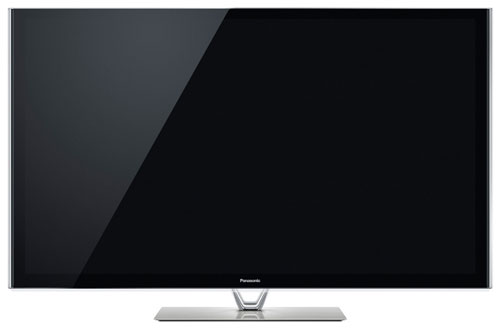
This doesn’t mean that the Viera VT60/VT65 series has suffered though. In fact, when we tested the 55-inch Panasonic TX-P55VT65B and the 65-inch TX-P65VT65B plasma-based 3D televisions earlier this year, we were so enthralled by their picture quality that we bestowed the pair our highest “Reference Level” award. Will the smallest model in the range, i.e the TX-P50VT65B which is the subject of today’s review, live up to the same lofty standard? Let’s find out.
Note: The user menu, connection ports and remote control on the TX-P50VT65 is identical to those found on the larger TX-P55VT65, so please refer to that review if you need more details or a refresher.
Note: Our 50in Panasonic VT65 review sample was calibrated using CalMAN 5, the industry-leading video calibration software.
Out of the box, we selected [THX Cinema] mode which in theory should yield the most accurate image on the VT65 without further calibration. In this picture preset, we found that there was a green tinge across almost the entire luminance range:
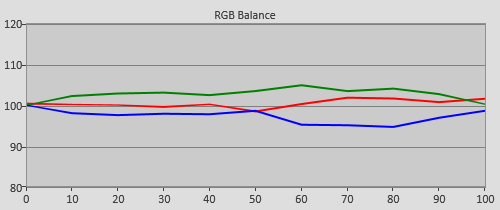 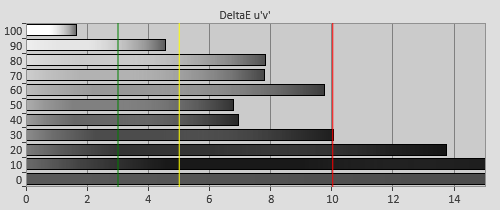 |
| Pre-calibration RGB tracking and delta errors (dEs) |
Of course, the Panasonic VT plasma comes with not only 2-point but also 10-point white balance controls in the [Custom] and [Professional] modes. Interestingly, just like the TX-P50GT60B we reviewed six months ago, the Viera TXP50VT65B clipped whiter-than-white (WTW) levels above 240 by default in the [THX Cinema] and [Professional] modes, requiring a drop in [Contrast] from the default value of “60” to “40” before the entire range of WTW shades is displayed. [Custom] mode, on the other hand, retained full WTW detail even at its default [Contrast] setting of “50“, which persuaded us to go with this preset even though only very rarely is WTW information (for example specular highlights) encoded in the majority of real-world video material.
Perhaps more intriguing is the fact that this behaviour of clipping WTW detail in the [THX Cinema] and [Professional] modes is not present on the bigger 55in and 65in Panasonic VT65, indicating that it’s specific only to the 50” screen size for whatever reason.
So we went to work in [Custom] mode, first using the 2p and then supplementing with the 10p white balance controls to achieve supremely accurate greyscale on the set:
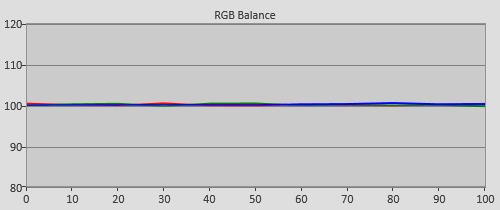 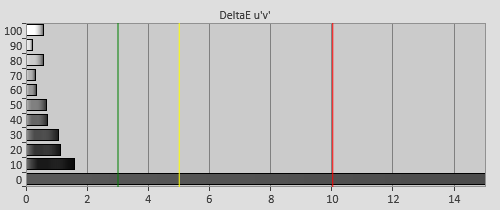 |
| Post-calibration RGB tracking and dEs in [Custom] mode |
If you’re watching Blu-ray movies in a dimly-lit viewing environment on the TX-P50VT65 that boasts some of the deepest blacks and greatest dynamic range available to consumers, it would be criminal not to aim for 2.4 gamma (instead of the more traditional 2.2) which injects so much “pop” and depth to the image.
![Pre-calibrated Gamma tracking in [THX Cinema] mode](https://www.hdtvtest.co.uk/news/wp-content/uploads/2018/04/hdtv_Panasonic-TXP50VT65_pre-gamma.png) | ![Post-calibrated Gamma tracking in [Custom] mode](https://www.hdtvtest.co.uk/news/wp-content/uploads/2018/04/hdtv_Panasonic-TXP50VT65_post-gamma.png) |
| Pre-calibration gamma tracking (2.4) | Post-calibration gamma tracking (2.37) |
We’d go so far as to say that any professional calibrator who – out of old habit or dogmatic stubbornness – doesn’t consider calibrating a 2013 Panasonic plasma to 2.4 would actually be doing his/her clients a massive disservice. After all, even the most authoritative organisation imaginable in the industry, namely the International Telecommunications Union (ITU), has recommended 2.4 as the EOTF (electro-optical transfer function) for flat-screen HD displays used in dark-room studio mastering.
We used the onboard 10-point gamma controls to flatten out the gamma tracking, though we had to be careful not to be overly aggressive since we discovered that excessive adjustments introduced more dynamic false contouring (DFC) in real-life content. Because of this, there remained a slight brightening of shadow detail, but we didn’t feel that this affected real-world performance in a negative way.
The Panasonic TX-P50VT65B’s out-of-the-box colour accuracy was already very good once [THX Cinema] mode was engaged, but this can be calibrated to even better, near-reference levels using the HSL-based colour management system (CMS) available in [Custom] and [Professional] modes, which allows for finetuning of all six primary (red, green, blue) and secondary (cyan, magenta, yellow) colours, as you can see from the charts below:
![Post-calibration Colour saturation tracking in [Custom] mode](https://www.hdtvtest.co.uk/news/wp-content/uploads/2018/04/hdtv_Panasonic-TXP50VT65_post-strack.jpg) |
| Post-calibration colour saturation tracking |
![Post-calibration colour luminance in [Custom] mode](https://www.hdtvtest.co.uk/news/wp-content/uploads/2018/04/hdtv_Panasonic-TXP50VT65_post-glum.png) |
| Post-calibration colour luminance (coloured bars=targets; black bars=measured values) |
| Dead pixels | None |
| Screen uniformity | Excellent |
| Overscanning on HDMI | 0% with [16:9 Overscan] “Off“ |
| Blacker than black | Passed |
| Calibrated black level (black screen) | 0.004 cd/m2 |
| Calibrated black level (ANSI checkerboard) | 0.007 cd/m2 |
| Black level retention | Stable |
| Primary chromaticity | Excellent |
| Scaling | Excellent |
| Video mode deinterlacing | Very effective jaggies reduction |
| Film mode deinterlacing | Passed 3:2 cadence in 480i, and 2:2 in 576i |
| Viewing angle | Excellent |
| Motion resolution | Excellent (1080 natively) |
| Digital noise reduction | Acceptable at baseline |
| Sharpness | “Clover leafing” on luma zone plate pattern; not visible in real-life content |
| Luma/Chroma bandwidth (2D Blu-ray) | Full Luma; Chroma vertically blurred even in [1080p Pure Direct] mode |
| Image retention | Very little |
| Posterization | Mild, though worse with poor source and fast motion |
| Phosphor trails | Very mild, though severity depends on individual susceptibility |
| 1080p/24 capability | Judder-free in 2D or 3D |
| Input lag (high-speed camera) | 23ms compared to lag-free CRT |
| Leo Bodnar input lag tester | 41ms |
| Full 4:4:4 reproduction (PC) | No |
Verdict
| Default [Normal] mode | 335 watts |
| Calibrated [Custom] mode | 172 watts |
| Standby | 1 watt |
The Panasonic TX-P50VT65B is without doubt the finest 50in flat-screen television you can buy on the market at this time of writing. It features some of the inkiest blacks ever seen on a large-sized HDTV, and can be calibrated to deliver wonderfully accurate greyscale and colours. Sampling a few of our favourite Blu-rays on the 50VT65, we couldn’t help but marvel at the amount of “pop” and insight on show. That such a high level of picture quality is available to consumers at such an affordable price (relative to 4K Ultra HD or OLED TVs) not only is a testament of Panasonic’s engineering prowess, but also brings into question how much more improvement can we expect from plasma display panel (PDP) technology, and at this price point. We suspect the answer is very little.
This is not to say that the TX-P50VT65 is without flaws (regardless of what subjective reviews claim, no TV is perfect, not even the legendary Pioneer Kuros), but these shortcomings are inherent to plasmas, and are generally inconsequential in the grand scheme of things. We detected some mild dynamic false contouring (DFC) and the occasional double images on fast-panning 50hz material, which could be mitigated fairly effectively by setting [Intelligent Frame Creation] to “Min“. There were also the typical plasma buzz whenever very bright content came on screen, as well as some background whirring noise from the two cooling fans at the rear of the panel. Whether you can hear these depends on your room acoustics (thick curtains and carpets provide better sound absorption) and your individual sensitivity – we weren’t really bothered.
Compared to its predecessor the VT50, this year’s Viera VT65 does not suffer from superimposed caps on both ends of the contrast spectrum (well done to Panasonic’s engineers for addressing this issue which we raised repeatedly in our reviews last year) in its most customisable picture presets (which also happen to exhibit less near-black dither than 2012 models). For this reason alone, we think the VT65 is a worthwhile upgrade over the VT50 – the former’s black level is even deeper too.
For some buyers, the choice will be between the TX-P50VT65B and the step-down TX-P50GT60B which is a few hundred pounds cheaper. From a picture quality perspective, both are first-rate HDTVs, with the VT holding a slight upper hand in terms of black level and anti-reflective filter. And when the VT65’s cutting-edge styling, integrated camera plus Freeview and Freesat HD twin-tuner recording capabilities are taken into account, we’re sure many viewers will agree it’s money well-spent, if only to secure bragging rights of owning the best 50-inch TV in town.
